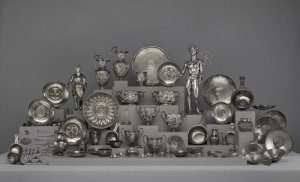
LOS ANGELES — Accidentally discovered by a French farmer plowing his field near the village of Berthouville in rural Normandy in 1830, the spectacular hoard of gilt-silver statuettes and vessels known as the Berthouville Treasure was an ancient offering to the Gallo-Roman god Mercury. Following four years of meticulous conservation and research in the J. Paul Getty Museum’s Antiquities Conservation Department, the exhibition Ancient Luxury and the Roman Silver Treasure from Berthouville, on view at the Getty Villa November 19, 2014, to August 17, 2015, will present this unique collection of ancient silver in its full splendor and offer new insights about ancient art, technology, religion, and cultural interaction. The opulent cache – in the collection of the Cabinet des médailles (now the Department of Coins, Medals and Antiques) at the Bibliothèque nationale de France – is displayed in its entirety for the first time outside of Paris, together with precious gems, jewelry, and other Roman luxury objects from the Cabinet’s royal collections.
“Since 2010, this magnificent collection of silver objects has been undergoing extensive conservation and study at the Getty Villa, providing us a unique opportunity to examine the production of Roman luxury materials and seeing what this has to teach us about the art, culture and religion of Roman Gaul,” says Timothy Potts, director of the J. Paul Getty Museum. “Being able to display this dazzling hoard at the Getty Villa is a great privilege for us and our visitors, and we have the added satisfaction of knowing that they will return to France much better understood and looking spectacularly better than before.”
____________________________________________
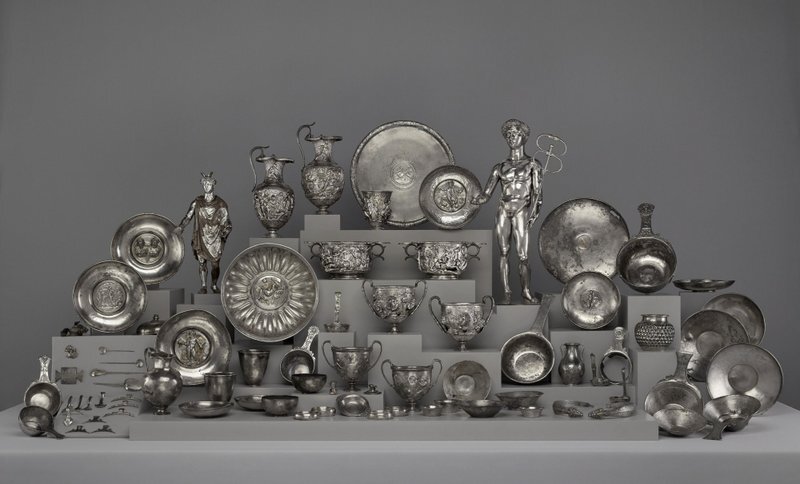
The entire collection of restored objects. Courtesy Gety Museum and Bibliothèque nationale de France, Département des monnaies, médailles et antiques, Paris
_______________________________________________
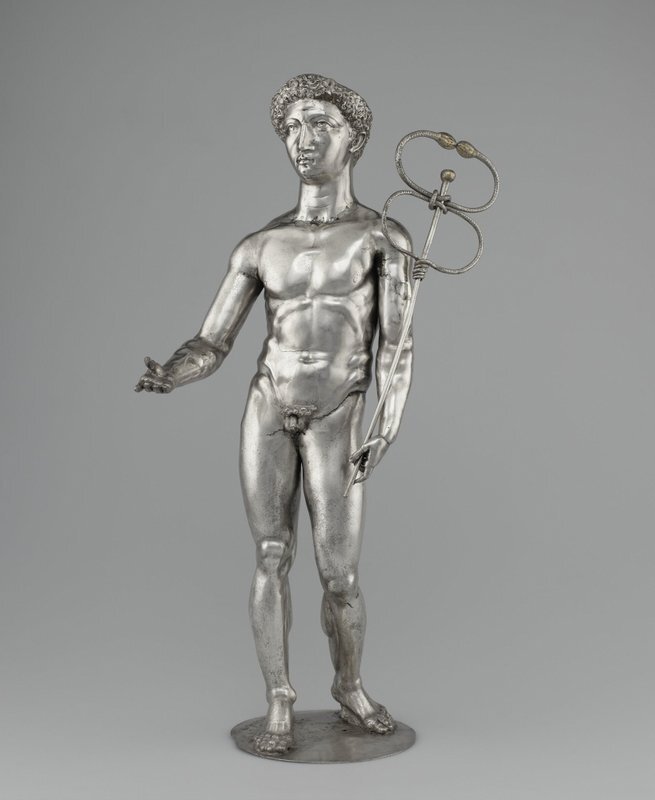
The Roman god Mercury, after restoration. Courtesy Getty Museum and Bibliothèque nationale de France, Département des monnaies, médailles et antiques, Paris ______________________________________
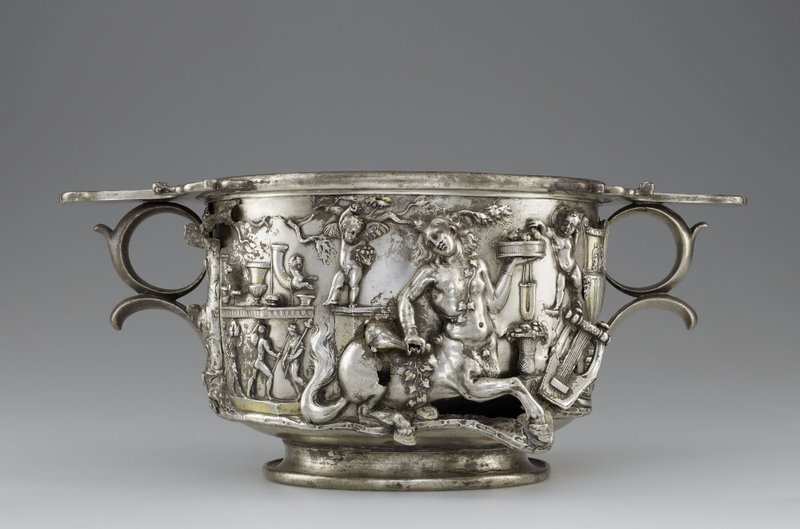
Pair of cups with centaurs, after restoration. Courtesy Gety Museum and Bibliothèque nationale de France, Département des monnaies, médailles et antiques, Paris
______________________________________________
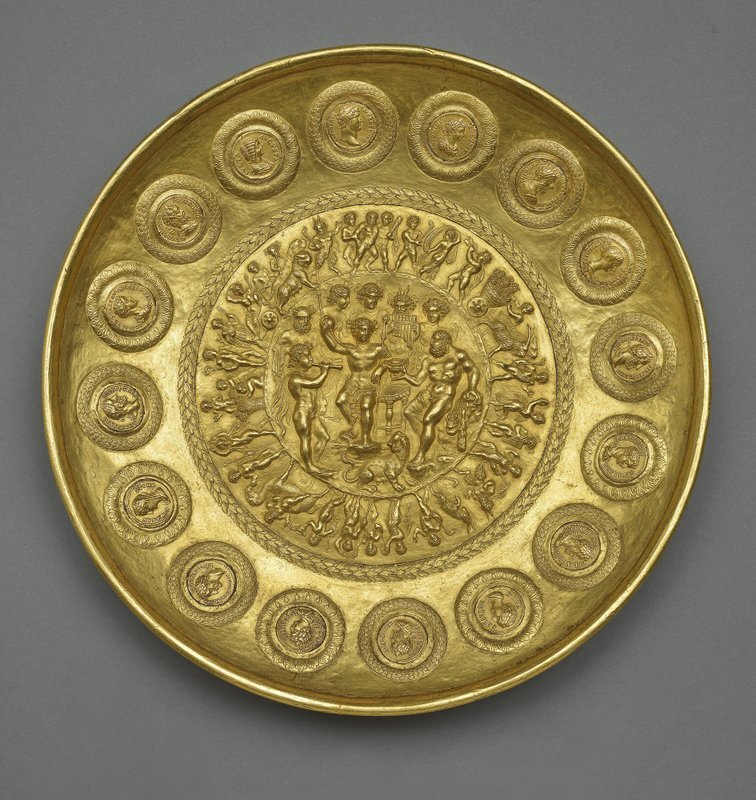
Offering Bowl with Bacchus, Hercules, and Coins. Courtesy Getty Museum and Bibliothèque nationale de France, Département des monnaies, médailles et antiques, Paris
_______________________________________________
While the treasure – consisting of about 90 silver objects weighing more than 50 pounds – was first discovered in 1830, it was not until 1861 and again in 1896 that the site was extensively surveyed and excavated, uncovering the foundations of a Gallo-Roman fanum, a square colonnaded precinct with two temples. One was dedicated to Mercury Canetonensis (of Canetonum), while the other was devoted to his mother Maia or his consort Rosmerta. A theater-shaped gathering space was also found nearby. The site survey did not reveal any evidence of an ancient settlement or cemetery in the immediate area, so it’s possible that Mercury’s sanctuary at Berthouville was a place of pilgrimage, perhaps visited during annual festivals.
The most impressive objects in the Berthouville Treasure bear Latin inscriptions stating that they were dedicated to Mercury by a Roman citizen named Quintus Domitius Tutus. Several of the vessels, profusely ornamented in high relief and then gilded, are recognized today as among the finest ancient Roman silver to survive. The elaborately decorated imagery of Tutus’s offerings, except for one ladle that was manufactured specifically for Mercury, feature Bacchic motifs and mythological scenes that are more appropriate to luxurious dining than religious observance. These items were probably presented to Mercury at Berthouville after initial use as private display silver. Subtle differences in their dedicatory inscriptions may indicate that they were given to the god over the course of a few years, again suggesting that it was perhaps offered during annual festivals.
Soon after its discovery, the treasure was acquired by the Bibliothèque nationale de France in Paris where it was cleaned and the disassociated parts of several vessels were reassembled. Since the treasure had been buried over centuries, many of the objects were heavily encrusted and the ancient solder that had held together their components often became separated. The nineteenth-century restoration included the removal of some of the tarnish, accretions, and harder encrustations, and left some deep scratches. Some of the corrosion was so tenacious that it had to be left in place, and a number of objects were restored with materials that were commonplace in the day, including solder, pine resin, and beeswax.
In December 2010 the entire treasure, as well as four unrelated late antique silver platters or missoria from the Cabinet’s collection, arrived at the Getty Villa for a comprehensive conservation treatment. The four-year project focused not only on restoring the works but on historical research, careful study, and meticulous cleaning. This treatment has revealed much of the original gilding, additional inscriptions, and valuable evidence for ancient production techniques as well as nineteenth-century methods of restoration.
“We are privileged that our colleagues in Paris have entrusted us with these exquisite objects. The opportunity to study them over an extended period of time has produced valuable new insights about the unsurpassed artistry of ancient Roman silversmiths,” said Kenneth Lapatin, exhibition curator and associate curator of antiquities at the J. Paul Getty Museum.
The exhibition also presents a variety of precious objects from the collection of the Cabinet des médailles at the Bibliothèque nationale de France, one of the premier repositories of ancient luxury arts. The objects on display include the four newly restored Late Antique missoria, cameos, intaglios, gold coins and jewelry, marbles, and bronzes. These surviving artifacts from the Cabinet’s collection not only demonstrate the skills of Roman craftsmen but also provide valuable information about social relations at the height of the empire in the first to sixth centuries A.D.
The four missoria, on view in the final section of the exhibition, were luxury objects in Late Antiquity. They were primarily intended to display the wealth, status, and cultural aspirations of their owners. The two largest platters are the famed “Shield of Scipio” (found in the Rhone near Avignon in 1636) and “Shield of Hannibal” (found in the Alps in 1714). The shape, scale, and imagery of these two platters led early scholars to erroneously identify them as votive shields of historical generals – the Roman Scipio Africanus and his rival, the Carthaginian Hannibal.
_________________
Ancient Luxury and the Roman Silver Treasure from Berthouville was organized by the J. Paul Getty Museum in collaboration with the Bibliothèque nationale de France, Département des Monnaies, médailles et antiques, Paris. The presentation at the Getty Villa is curated by Kenneth Lapatin, associate curator of antiquities at the J. Paul Getty Museum. After its presentation at the Getty Villa, the exhibition will travel to the Fine Arts Museums of San Francisco, the Nelson-Atkins Museum in Kansas City, the Museum of Fine Arts, Boston, and the Museum of Fine Arts, Houston, before returning to France.
The conservation work on the Berthouville Treasure was generously supported by the Getty Museum’s Villa Council, a dedicated group of individuals interested in expanding knowledge of the ancient world.
The J. Paul Getty Trust is an international cultural and philanthropic institution devoted to the visual arts that includes the J. Paul Getty Museum, the Getty Research Institute, the Getty Conservation Institute, and the Getty Foundation. The J. Paul Getty Trust and Getty programs serve a varied audience from two locations: the Getty Center in Los Angeles and the Getty Villa in Malibu.
Visiting the Getty Villa: The Getty Villa is open
Wednesday through
Monday, 10 a.m. to 5 p.m. It is closed
Tuesday and most major holidays, open on
July 4. Admission to the Getty Villa is always free. A ticket is required for admission. Tickets can be ordered in advance, or on the day of your visit, at
www.getty.edu/visit or at
(310) 440-7300. Parking is $15 per car. Groups of 15 or more must make reservations by phone. For more information, call
(310) 440-7300 (English or Spanish);
(310) 440-7305 (TTY line for the deaf or hearing impaired). The Getty Villa is at 17985 Pacific Coast Highway, Pacific Palisades, California.
___________________________________________________
Read about the most fascinating discoveries with a premium subscription to Popular Archaeology Magazine. Find out what Popular Archaeology Magazine is all about. AND MORE:
On the go? Get the smartphone version of Popular Archaeology as an app or as an ebook.

Popular Archaeology’s annual Discovery Edition eBook is a selection of the best stories published in Popular Archaeology Magazine in past issues, with an emphasis on some of the most significant, groundbreaking, or fascinating discoveries in the fields of archaeology and paleoanthropology and related fields. At least some of the articles have been updated or revised specifically for the Discovery edition. We can confidently say that there is no other single issue of an archaeology-related magazine, paper print or online, that contains as much major feature article content as this one. The latest issue, volume 2, has just been released. Go to the Discovery edition page for more information.










